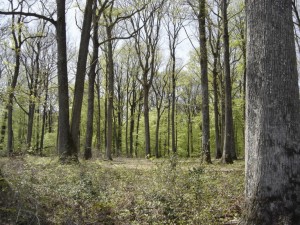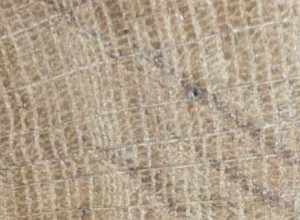
Not too many years ago, it was popular for cooperages to sell French oak barrels based on the forest origins of their wood: Allier, Troncais, Vosges, etc. Now it’s more common for coopers to distinguish barrels according to grain type, as determined by the average width of a tree’s annual growth rings: fine/tight grain, open/wide grain, etc. This is meant to give winemakers an indication of the tannin and aromatic profiles of the barrels they are purchasing.
I dug up a study from 1999 from the American Journal of Enology and Viticulture (AJEV) that compared barrels based on forest differences, grain types and porosity. The study measured the wood properties of the individual trees as well as sensory and oak lactone levels in wines aged in the barrels made from those trees. Each barrel was made from only one tree (11 total trees, four forests, two oak species). The conclusion was that the aromatic differences found between barrels were more closely related to oak lactone levels than forest origin. Trees within a single forest yielded more of these differences than trees from separate forests.
The AJEV also concluded that aromatic differences were more related to oak species than grain type and referenced a study in which sessile oak (Quercus Petraea) was found to contain, on average, twice the levels of oak lactones as pedunculated oaks (Quercus Robur). However, grain type is still relevant. Pedunculate oak is better adapted to a less densely planted forest, so trees tend to have more open grain than tight grain wood. Sessile oak dominates in a dense forest environment which yields more tight grain wood.
It wouldn’t be practical for a cooperage to select wood based on species because there are hundreds of hybrids of oak species due to cross-pollination within the forests. It would also be tough to measure the oak lactone levels of each tree. So cooperages end up creating a blend of trees and species to reduce overall variation and make distinctions based on grain type or forest origin, whether relevant or not. It is more likely that the biggest difference between barrels is found from cooperage to cooperage because of variations in their manufacturing processes (mainly toasting).
Around the time of the AJEV study, Nick Goldschmidt ran a trial at Simi winery to measure the differences between barrels from different forests and barrels made by different coopers. He concluded that the individual cooper (one person at the cooperage making the barrels) had more of an influence on a finished wine’s taste than the geographic source of the wood (from French forests). In other words, the same barrel made by one person versus another person yielded differences greater than forest differences. David Ramey has a similar opinion. At the 2015 Wines and Vines Oak Conference and he made the statement, “There are more differences between coopers [cooperages] than forests.”
In 2011 Thomas Collins from Department of Viticulture and Enology, University of California, Davis presented findings from a study where he found some measurable chemical differences related to grain tightness and forest of origin. But he also concluded that these differences were not significant enough to result in discernible sensory differences among a panel of expert tasters. In a recent conversation I had with Thomas, he told me that based on trials he had done while head of R & D at Treasury Wine Estates, the influence of barrel toasting was so significant it overpowered any nuances that might have been detectable based on grain type or forest origin.
 In a study presented by Chene & Cie in the July 2014 issue of Practical Vineyard and Winery, wines aged in tight grain and open grain barrels for a period of 12 months were analyzed for aromatic compound and tannin levels. The conclusion was that barrels made from tight grain wood released more aromatic compounds (eugenol, whiskey lactones), and barrels made from open grain wood released more tannins. Logically this makes sense since tight grain wood contains more “spring wood,” which is richer in vessels (transports sap full of nutrients, minerals and sugars), and open grain wood contains more “summer wood” which is more fibrous, so has more tannin.
In a study presented by Chene & Cie in the July 2014 issue of Practical Vineyard and Winery, wines aged in tight grain and open grain barrels for a period of 12 months were analyzed for aromatic compound and tannin levels. The conclusion was that barrels made from tight grain wood released more aromatic compounds (eugenol, whiskey lactones), and barrels made from open grain wood released more tannins. Logically this makes sense since tight grain wood contains more “spring wood,” which is richer in vessels (transports sap full of nutrients, minerals and sugars), and open grain wood contains more “summer wood” which is more fibrous, so has more tannin.
Here are my conclusions:
- There are minimal differences based on forest origin alone, but one forest might have more of certain species than another, which could predispose for oak lactone levels, grain types and therefore aromatic compounds.
- Cooperages cannot practically select wood based on species or oak lactone levels of individual trees, but they can make selections based on location and grain type (as an added bonus, some cooperages now select staves based on measured tannin levels).
- There are differences in the structural and aromatic compounds of tight grain wood versus open grain wood, but whether these differences are significant enough to be noticed through tasting is a question, and they likely don’t outweigh the differences created through a cooperage’s seasoning and toasting processes.
- It seems universally accepted that the potential for aromatics is greater in tight grain wood and tannins are higher in open grain wood.
I would love to hear from winemakers on this topic. What differences have you noticed based on specific parameters in trials you’ve conducted? Have you learned of any studies that contrdict what’s summarized here? Please share your comments below.